seats MERCEDES-BENZ CLS 2018 Owners Manual
[x] Cancel search | Manufacturer: MERCEDES-BENZ, Model Year: 2018, Model line: CLS, Model: MERCEDES-BENZ CLS 2018Pages: 334, PDF Size: 7.87 MB
Page 4 of 334
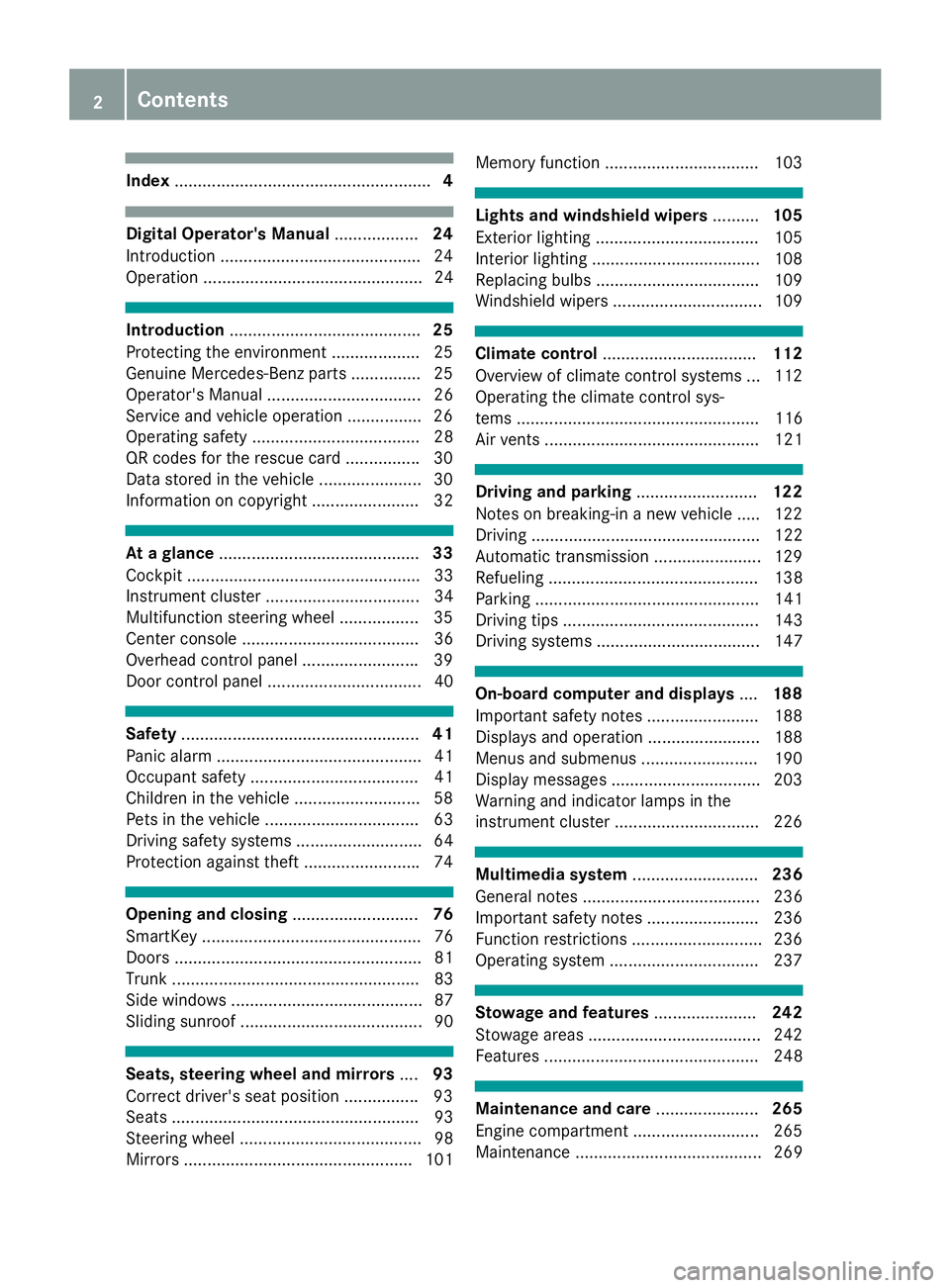
Index ....................................................... 4
Digital Operator's Manual .................. 24
Introduction .......................................... .2 4
Operation ............................................... 24
Introduction ......................................... 25
Protecting the environment .................. .2 5
Genuine Mercedes-Benz parts .............. .2 5
Operator's Manual ................................. 26
Service and vehicle operation ............... .2 6
Operating safety .................................... 28
QR codes for the rescue card ............... .3 0
Data stored in the vehicle ...................... 30
Information on copyright ....................... 32
At a glance ........................................... 33
Cockpit .................................................. 33
Instrument cluster ................................. 34
Multifunction steering wheel ................. 35
Center console ...................................... 36
Overhead control panel ........................ .3 9
Door control panel ................................. 40
Safety ................................................... 41
Panic alarm ............................................ 41
Occupant safety .................................... 41
Children in the vehicle ........................... 58
Pets in the vehicle ................................. 63
Driving safety systems ........................... 64
Protection against theft ........................ .7 4
Opening and closing ........................... 76
SmartKey ............................................... 76
Doors ..................................................... 81
Trunk ..................................................... 83
Side windows ......................................... 87
Sliding sunroof ....................................... 90
Seats, steering wheel and mirrors .... 93
Correct driver's seat position ............... .9 3
Seats ..................................................... 93
Steering wheel ....................................... 98
Mirrors ................................................. 101 Memory function ................................. 103
Lights and windshield wipers .......... 105
Exterior lighting ................................... 105
Interior lighting .................................... 108
Replacing bulbs ................................... 109
Windshield wipers ................................ 109
Climate control ................................. 112
Overview of climate control systems ... 112
Operating the climate control sys-
tems .................................................... 116
Air vents .............................................. 121
Driving and parking .......................... 122
Notes on breaking-in a new vehicle ..... 122
Driving ................................................. 122
Automatic transmission ....................... 129
Refueling ............................................. 138
Parking ................................................ 141
Driving tips .......................................... 143
Driving systems ................................... 147
On-board computer and displays .... 188
Important safety notes ........................ 188
Displays and operation ........................ 188
Menus and submenus ......................... 190
Display messages ................................ 203
Warning and indicator lamps in the
instrument cluster ............................... 226
Multimedia system ........................... 236
General notes ...................................... 236
Important safety notes ........................ 236
Function restrictions ............................ 236
Operating system ................................ 237
Stowage and features ...................... 242
Stowage areas ..................................... 242
Features .............................................. 248
Maintenance and care ...................... 265
Engine compartment ........................... 265
Maintenance ........................................ 2692
Contents
Page 18 of 334
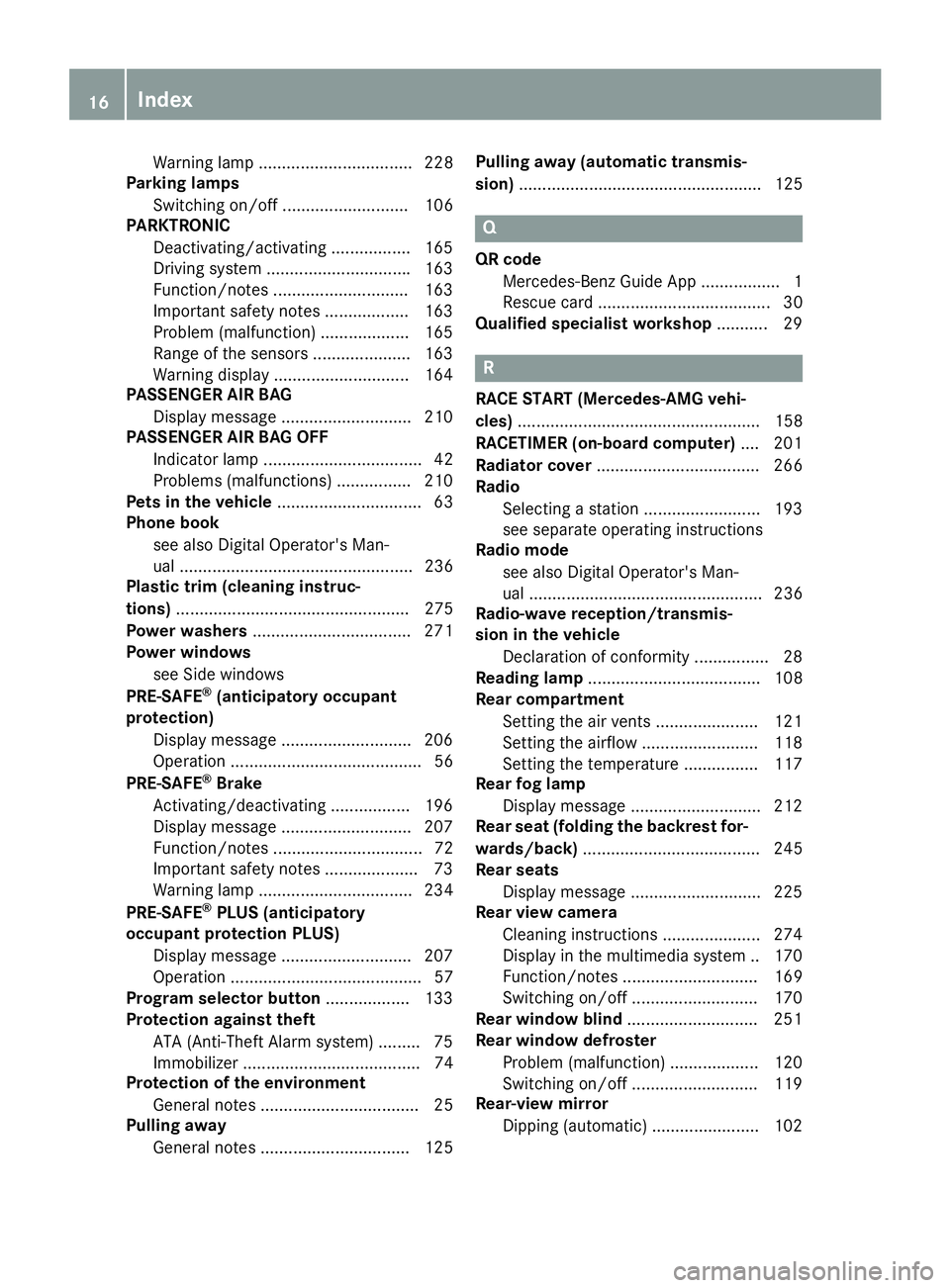
Warning lamp ................................. 228
Parking lamps
Switching on/off ........................... 106
PARKTRONIC
Deactivating/activating ................. 165
Driving system .............................. .1 63
Function/notes ............................ .1 63
Important safety notes .................. 163
Problem (malfunction) ................... 165
Range of the sensors ..................... 163
Warning display ............................. 164
PASSENGER AIR BAG
Display message ............................ 210
PASSENGER AIR BAG OFF
Indicator lamp .................................. 42
Problems (malfunctions) ................ 210
Pets in the vehicle ............................... 63
Phone book
see also Digital Operator's Man-
ual .................................................. 236
Plastic trim (cleaning instruc-
tions) .................................................. 275
Power washers .................................. 271
Power windows
see Side windows
PRE-SAFE ®
(anticipatory occupant
protection)
Display message ............................ 206
Operation ......................................... 56
PRE-SAFE ®
Brake
Activating/deactivating ................. 196
Display message ............................ 207
Function/notes ................................ 72
Important safety notes .................... 73
Warning lamp ................................. 234
PRE-SAFE ®
PLUS (anticipatory
occupant protection PLUS)
Display message ............................ 207
Operation ......................................... 57
Program selector button .................. 133
Protection against theft
ATA (Anti-Theft Alarm system) ......... 75
Immobilizer ...................................... 74
Protection of the environment
General notes .................................. 25
Pulling away
General notes ................................ 125 Pulling away (automatic transmis-
sion) .................................................... 125
Q QR code
Mercedes-Benz Guide App ................. 1
Rescue card ..................................... 30
Qualified specialist workshop ........... 29
R RACE START (Mercedes-AMG vehi-
cles) .................................................... 158
RACETIMER (on-board computer) .... 201
Radiator cover ................................... 266
Radio
Selecting a station ......................... 193
see separate operating instructions
Radio mode
see also Digital Operator's Man-
ual .................................................. 236
Radio-wave reception/transmis-
sion in the vehicle
Declaration of conformity ................ 28
Reading lamp ..................................... 108
Rear compartment
Setting the air vents ...................... 121
Setting the airflow ......................... 118
Setting the temperature ................ 117
Rear fog lamp
Display message ............................ 212
Rear seat (folding the backrest for-
wards/back) ...................................... 245
Rear seats
Display message ............................ 225
Rear view camera
Cleaning instructions ..................... 274
Display in the multimedia system .. 170
Function/notes ............................. 169
Switching on/off ........................... 170
Rear window blind ............................ 251
Rear window defroster
Problem (malfunction) ................... 120
Switching on/off ........................... 119
Rear-view mirror
Dipping (automatic) ....................... 10216
Index
Page 19 of 334
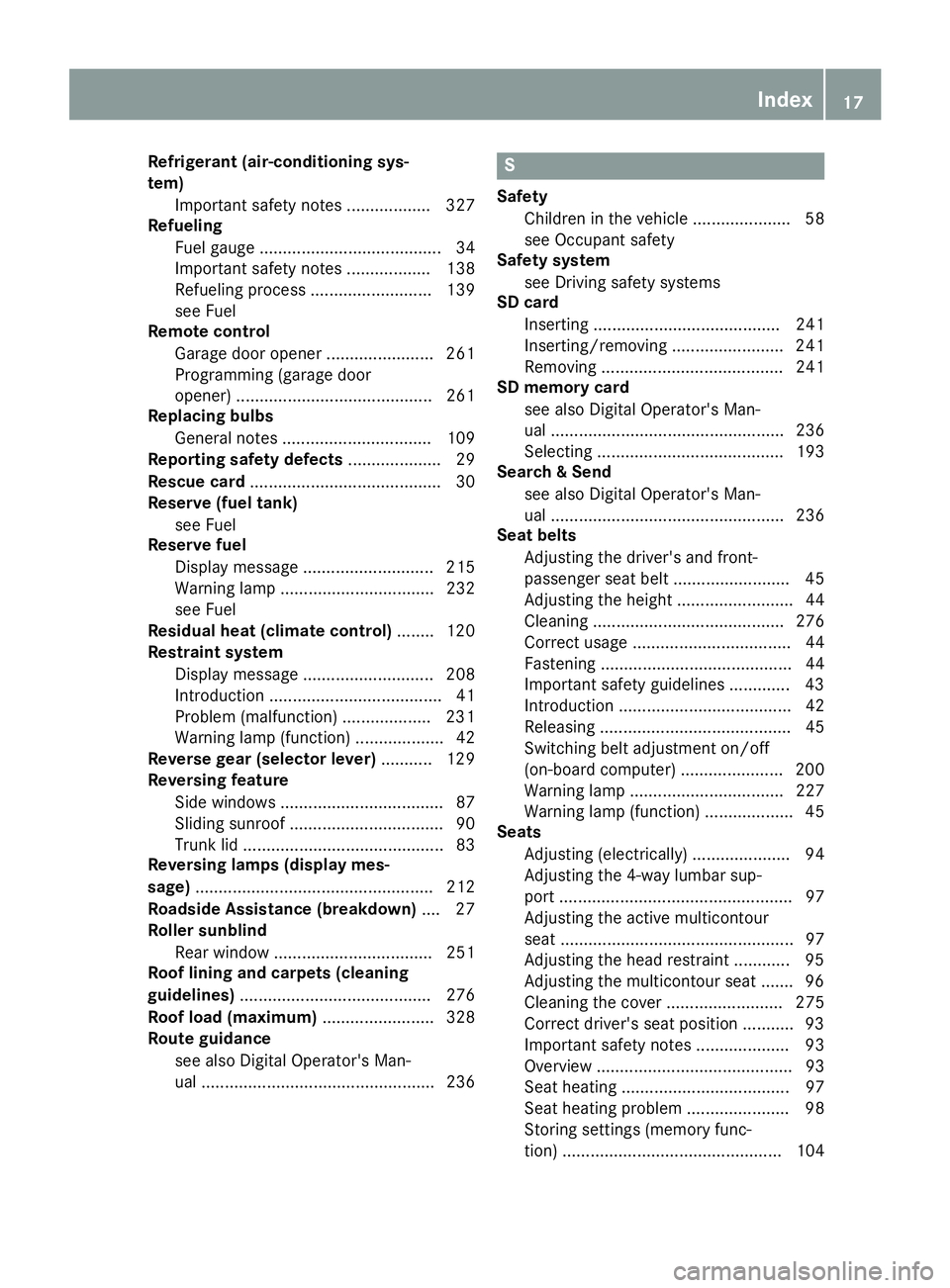
Refrigerant (air-conditioning sys-
tem)
Important safety notes .................. 327
Refueling
Fuel gauge ....................................... 34
Important safety notes .................. 138
Refueling process .......................... 139
see Fuel
Remote control
Garage door opener ....................... 261
Programming (garage door
opener) .......................................... 261
Replacing bulbs
General notes ................................ 109
Reporting safety defects .................... 29
Rescue card ......................................... 30
Reserve (fuel tank)
see Fuel
Reserve fuel
Display message ............................ 215
Warning lamp ................................. 232
see Fuel
Residual heat (climate control) ........ 120
Restraint system
Display message ............................ 208
Introduction ..................................... 41
Problem (malfunction) ................... 231
Warning lamp (function) ................... 42
Reverse gear (selector lever) ........... 129
Reversing feature
Side windows ................................... 87
Sliding sunroof ................................. 90
Trunk lid ........................................... 83
Reversing lamps (display mes-
sage) ................................................... 212
Roadside Assistance (breakdown) .... 27
Roller sunblind
Rear window .................................. 251
Roof lining and carpets (cleaning
guidelines) ......................................... 276
Roof load (maximum) ........................ 328
Route guidance
see also Digital Operator's Man-
ual .................................................. 236 S Safety
Children in the vehicle ..................... 58
see Occupant safety
Safety system
see Driving safety systems
SD card
Inserting ........................................ 241
Inserting/removing ........................ 241
Removing ....................................... 241
SD memory card
see also Digital Operator's Man-
ual .................................................. 236
Selecting ........................................ 193
Search & Send
see also Digital Operator's Man-
ual .................................................. 236
Seat belts
Adjusting the driver's and front-
passenger seat belt ......................... 45
Adjusting the height ......................... 44
Cleaning ......................................... 276
Correct usage .................................. 44
Fastening ......................................... 44
Important safety guidelines ............. 43
Introduction ..................................... 42
Releasing ......................................... 45
Switching belt adjustment on/off
(on-board computer) ...................... 200
Warning lamp ................................. 227
Warning lamp (function) ................... 45
Seats
Adjusting (electrically) ..................... 94
Adjusting the 4-way lumbar sup-
port .................................................. 97
Adjusting the active multicontour
seat .................................................. 97
Adjusting the head restraint ............ 95
Adjusting the multicontour seat ....... 96
Cleaning the cover ......................... 275
Correct driver's seat position ........... 93
Important safety notes .................... 93
Overview .......................................... 93
Seat heating .................................... 97
Seat heating problem ...................... 98
Storing settings (memory func-
tion) ............................................... 104 Index 17
Page 45 of 334
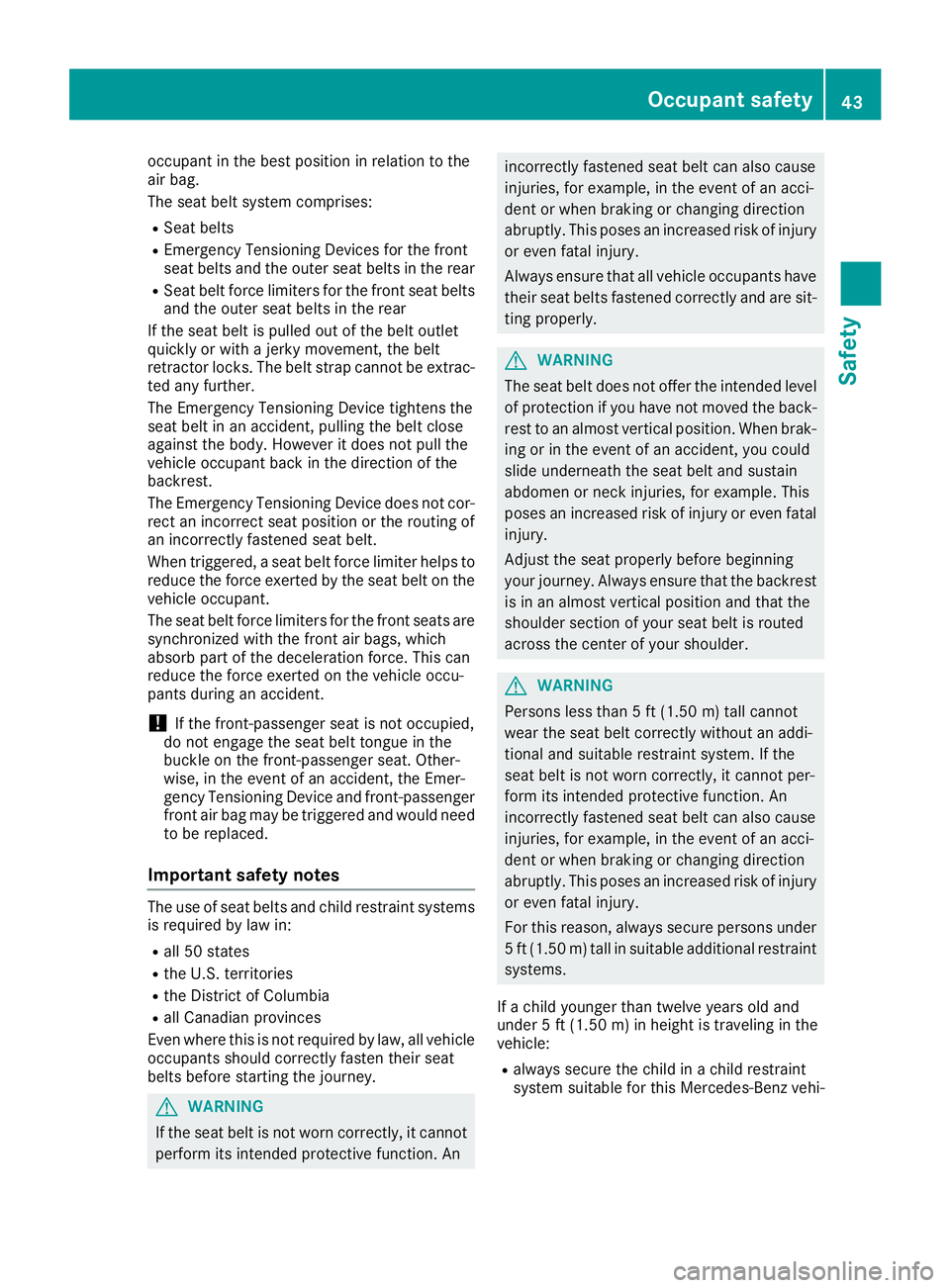
occupant in the best position in relation to the
air bag.
The seat belt system comprises: R
Seat belts R
Emergency Tensioning Devices for the front
seat belts and the outer seat belts in the rear R
Seat belt force limiters for the front seat belts
and the outer seat belts in the rear
If the seat belt is pulled out of the belt outlet
quickly or with a jerky movement, the belt
retractor locks. The belt strap cannot be extrac-
ted any further.
The Emergency Tensioning Device tightens the
seat belt in an accident, pulling the belt close
against the body. However it does not pull the
vehicle occupant back in the direction of the
backrest.
The Emergency Tensioning Device does not cor-
rect an incorrect seat position or the routing of
an incorrectly fastened seat belt.
When triggered, a seat belt force limiter helps to
reduce the force exerted by the seat belt on the
vehicle occupant.
The seat belt force limiters for the front seats are
synchronized with the front air bags, which
absorb part of the deceleration force. This can
reduce the force exerted on the vehicle occu-
pants during an accident.
! If the front-passenger seat is not occupied,
do not engage the seat belt tongue in the
buckle on the front-passenger seat. Other-
wise, in the event of an accident, the Emer-
gency Tensioning Device and front-passenger
front air bag may be triggered and would need
to be replaced.
Important safety notes The use of seat belts and child restraint systems
is required by law in: R
all 50 states R
the U.S. territories R
the District of Columbia R
all Canadian provinces
Even where this is not required by law, all vehicle
occupants should correctly fasten their seat
belts before starting the journey.
G WARNING
If the seat belt is not worn correctly, it cannot
perform its intended protective function. An incorrectly fastened seat belt can also cause
injuries, for example, in the event of an acci-
dent or when braking or changing direction
abruptly. This poses an increased risk of injury
or even fatal injury.
Always ensure that all vehicle occupants have
their seat belts fastened correctly and are sit-
ting properly.
G WARNING
The seat belt does not offer the intended level
of protection if you have not moved the back-
rest to an almost vertical position. When brak-
ing or in the event of an accident, you could
slide underneath the seat belt and sustain
abdomen or neck injuries, for example. This
poses an increased risk of injury or even fatal
injury.
Adjust the seat properly before beginning
your journey. Always ensure that the backrest
is in an almost vertical position and that the
shoulder section of your seat belt is routed
across the center of your shoulder.
G WARNING
Persons less than 5 ft (1.50 m) tall cannot
wear the seat belt correctly without an addi-
tional and suitable restraint system. If the
seat belt is not worn correctly, it cannot per-
form its intended protective function. An
incorrectly fastened seat belt can also cause
injuries, for example, in the event of an acci-
dent or when braking or changing direction
abruptly. This poses an increased risk of injury
or even fatal injury.
For this reason, always secure persons under
5 ft (1.50 m) tall in suitable additional restraint
systems.
If a child younger than twelve years old and
under 5 ft (1.50 m) in height is traveling in the
vehicle: R
always secure the child in a child restraint
system suitable for this Mercedes-Benz vehi-Occupant safety 43
Safety Z
Page 48 of 334
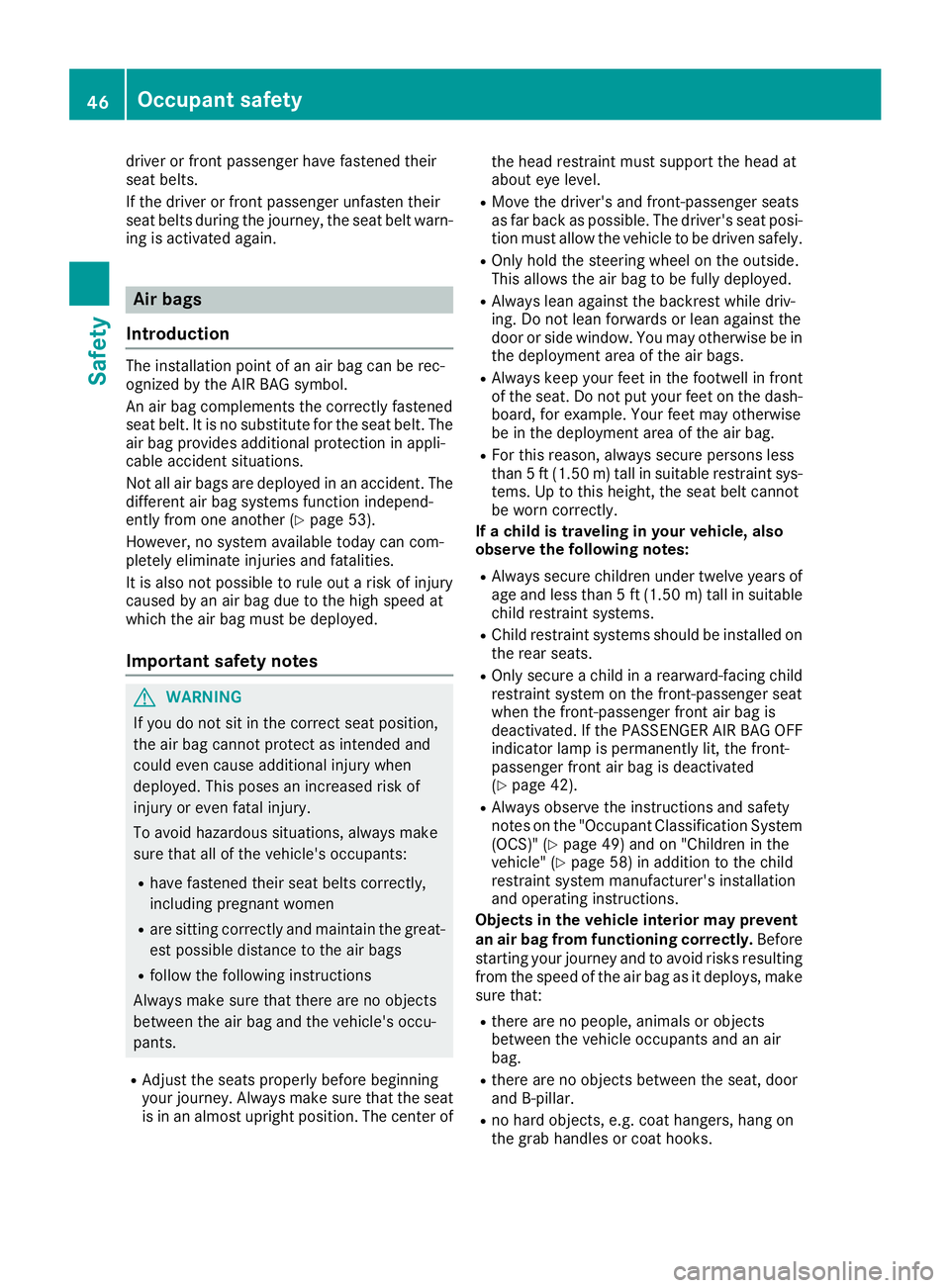
driver or front passenger have fastened their
seat belts.
If the driver or front passenger unfasten their
seat belts during the journey, the seat belt warn-
ing is activated again.
Air bags
Introduction The installation point of an air bag can be rec-
ognized by the AIR BAG symbol.
An air bag complements the correctly fastened
seat belt. It is no substitute for the seat belt. The
air bag provides additional protection in appli-
cable accident situations.
Not all air bags are deployed in an accident. The
different air bag systems function independ-
ently from one another ( Y
page 53).
However, no system available today can com-
pletely eliminate injuries and fatalities.
It is also not possible to rule out a risk of injury
caused by an air bag due to the high speed at
which the air bag must be deployed.
Important safety notes
G WARNING
If you do not sit in the correct seat position,
the air bag cannot protect as intended and
could even cause additional injury when
deployed. This poses an increased risk of
injury or even fatal injury.
To avoid hazardous situations, always make
sure that all of the vehicle's occupants: R
have fastened their seat belts correctly,
including pregnant women R
are sitting correctly and maintain the great-
est possible distance to the air bags R
follow the following instructions
Always make sure that there are no objects
between the air bag and the vehicle's occu-
pants. R
Adjust the seats properly before beginning
your journey. Always make sure that the seat
is in an almost upright position. The center of the head restraint must support the head at
about eye level. R
Move the driver's and front-passenger seats
as far back as possible. The driver's seat posi-
tion must allow the vehicle to be driven safely. R
Only hold the steering wheel on the outside.
This allows the air bag to be fully deployed. R
Always lean against the backrest while driv-
ing. Do not lean forwards or lean against the
door or side window. You may otherwise be in
the deployment area of the air bags. R
Always keep your feet in the footwell in front
of the seat. Do not put your feet on the dash-
board, for example. Your feet may otherwise
be in the deployment area of the air bag. R
For this reason, always secure persons less
than 5 ft (1.50 m) tall in suitable restraint sys-
tems. Up to this height, the seat belt cannot
be worn correctly.
If a child is traveling in your vehicle, also
observe the following notes: R
Always secure children under twelve years of
age and less than 5 ft (1.50 m) tall in suitable
child restraint systems. R
Child restraint systems should be installed on
the rear seats. R
Only secure a child in a rearward-facing child
re straint system on the front-passenger seat
when the front-passenger front air bag is
deactivated. If the PASSENGER AIR BAG OFF
indicator lamp is permanently lit, the front-
passenger front air bag is deactivated
( Y
page 42). R
Always observe the instructions and safety
notes on the "Occupant Classification System
(OCS)" ( Y
page 49) and on "Children in the
vehicle" ( Y
page 58 )i n addition to the child
restraint system manufacturer's installation
and operating instructions.
Objects in the vehicle interior may prevent
an air bag from functioning correctly. Before
starting your journey and to avoid risks resulting
from the speed of the air bag as it deploys, make
sure that: R
there are no people, animals or objects
between the vehicle occupants and an air
bag. R
there are no objects between the seat, door
and B-pillar. R
no hard objects, e.g. coat hangers, hang on
the grab handles or coat hooks.46
Occupant safety
Safety
Page 49 of 334
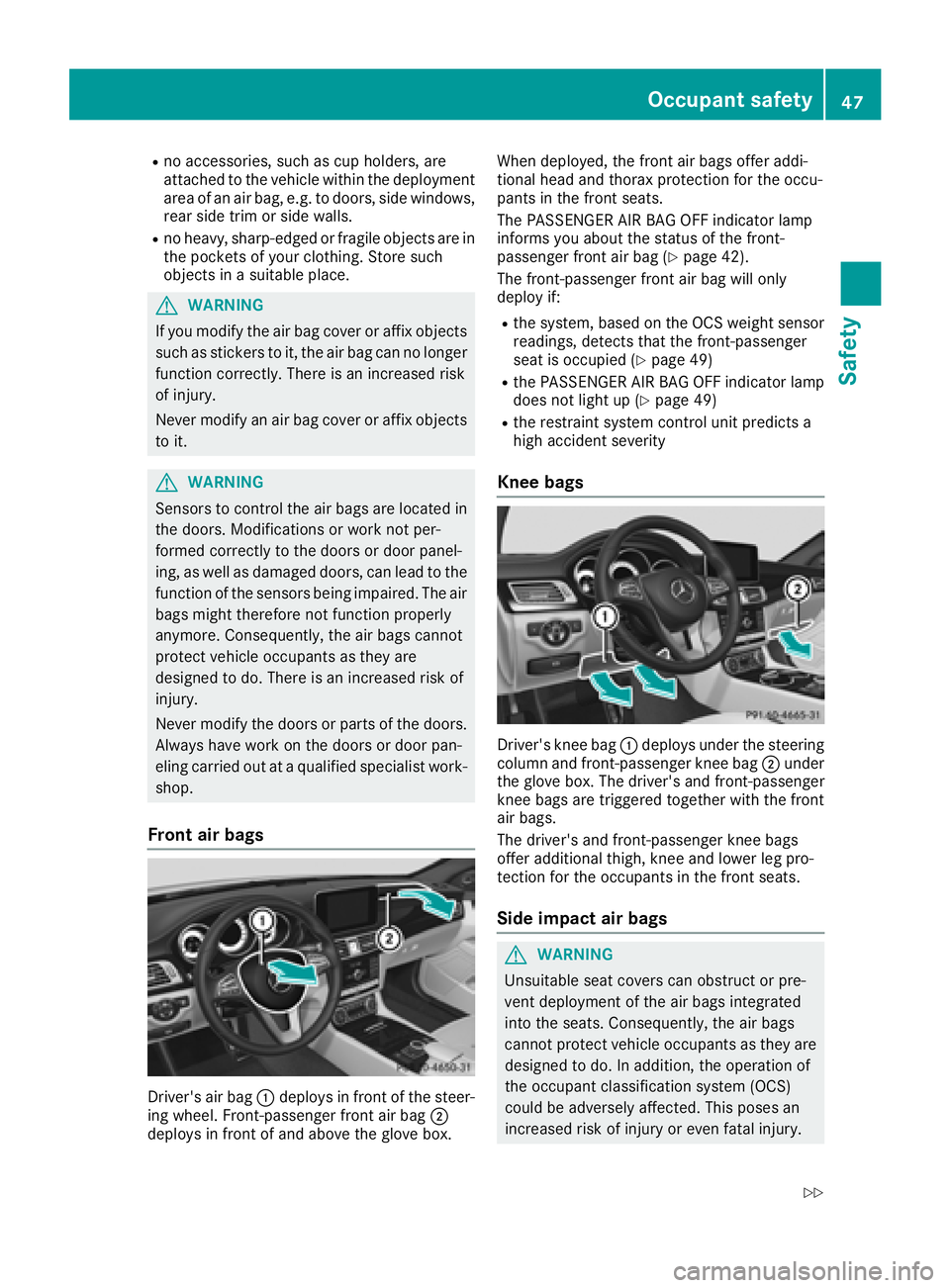
R
no accessories, such as cup holders, are
attached to the vehicle within the deployment
area of an air bag, e.g. to doors, side windows,
rear side trim or side walls. R
no heavy, sharp-edged or fragile objects are in
the pockets of your clothing. Store such
objects in a suitable place.
G WARNING
If you modify the air bag cover or affix objects
such as stickers to it, the air bag can no longer
function correctly. There is an increased risk
of injury.
Never modify an air bag cover or affix objects
to it.
G WARNING
Sensors to control the air bags are located in
the doors. Modifications or work not per-
formed correctly to the doors or door panel-
ing, as well as damaged doors, can lead to the
function of the sensors being impaired. The air
bags might therefore not function properly
anymore. Consequently, the air bags cannot
protect vehicle occupants as they are
designed to do. There is an increased risk of
injury.
Never modify the doors or parts of the doors.
Always have work on the doors or door pan-
eling carried out at a qualified specialist work-
shop.
Front air bags
Driver's air bag �C deploys in front of the steer-
ing wheel. Front-passenger front air bag �D
deploys in front of and above the glove box. When deployed, the front air bags offer addi-
tional head and thorax protection for the occu-
pants in the front seats.
The PASSENGER AIR BAG OFF indicator lamp
informs you about the status of the front-
passenger front air bag ( Y
page 42).
The front-passenger front air bag will only
deploy if: R
the system, based on the OCS weight sensor
readings, detects that the front-passenger
seat is occupied ( Y
page 49)R
the PASSENGER AIR BAG OFF indicator lamp
does not light up ( Y
page 49)R
the restraint system control unit predicts a
high accident severity
Knee bags
Driver's knee bag �C deploys under the steering
column and front-passenger knee bag �D under
the glove box. The driver's and front-passenger
knee bags are triggered together with the front
air bags.
The driver's and front-passenger knee bags
offer additional thigh, knee and lower leg pro-
tection for the occupants in the front seats.
Side impact air bags
G WARNING
Unsuitable seat covers can obstruct or pre-
vent deployment of the air bags integrated
into the seats. Consequently, the air bags
cannot protect vehicle occupants as they are
designed to do. In addition, the operation of
the occupant classification system (OCS)
could be adversely affected. This poses an
increased risk of injury or even fatal injury.Occupant safety 47
Safety Z
Page 50 of 334
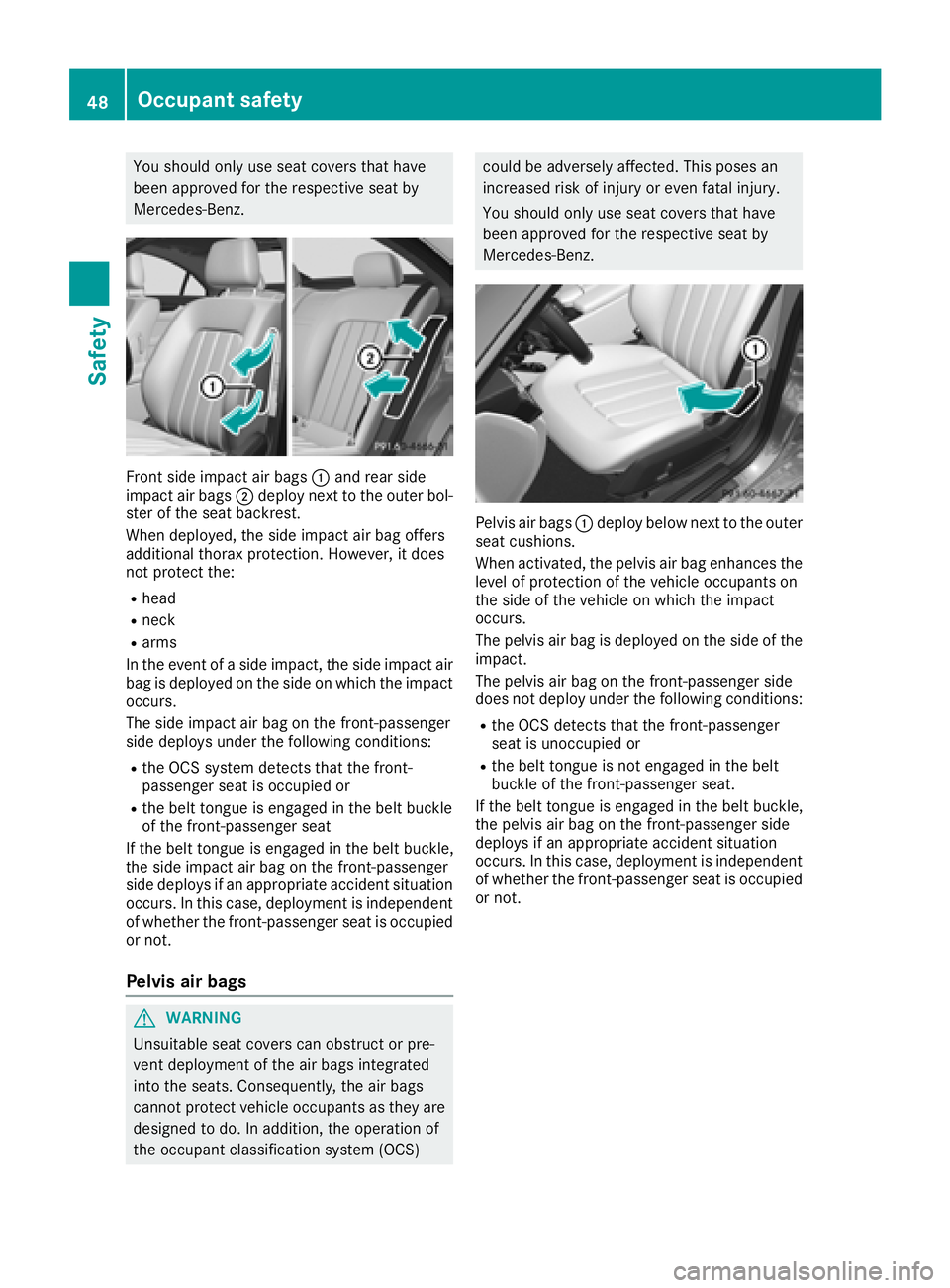
You should only use seat covers that have
been approved for the respective seat by
Mercedes-Benz.
Front side impact air bags �C and rear side
impact air bags �D deploy next to the outer bol-
ster of the seat backrest.
When deployed, the side impact air bag offers
additional thorax protection. However, it does
not protect the: R
head R
neck R
arms
In the event of a side impact, the side impact air
bag is deployed on the side on which the impact
occurs.
The side impact air bag on the front-passenger
side deploys under the following conditions: R
the OCS system detects that the front-
passenger seat is occupied or R
the belt tongue is engaged in the belt buckle
of the front-passenger seat
If the belt tongue is engaged in the belt buckle,
the side impact air bag on the front-passenger
side deploys if an appropriate accident situation
occurs. In this case, deployment is independent
of whether the front-passenger seat is occupied
or not.
Pelvis air bags
G WARNING
Unsuitable seat covers can obstruct or pre-
vent deployment of the air bags integrated
into the seats. Consequently, the air bags
cannot protect vehicle occupants as they are
designed to do. In addition, the operation of
the occupant classification system (OCS) could be adversely affected. This poses an
increased risk of injury or even fatal injury.
You should only use seat covers that have
been approved for the respective seat by
Mercedes-Benz.
Pelvis air bags �C deploy below next to the outer
seat cushions.
When activated, the pelvis air bag enhances the
level of protection of the vehicle occupants on
the side of the vehicle on which the impact
occurs.
The pelvis air bag is deployed on the side of the
impact.
The pelvis air bag on the front-passenger side
does not deploy under the following conditions: R
the OCS detects that the front-passenger
seat is unoccupied or R
the belt tongue is not engaged in the belt
buckle of the front-passenger seat.
If the belt tongue is engaged in the belt buckle,
the pelvis air bag on the front-passenger side
deploys if an appropriate accident situation
occurs. In this case, deployment is independent
of whether the front-passenger seat is occupied
or not.48
Occupant safety
Safety
Page 57 of 334
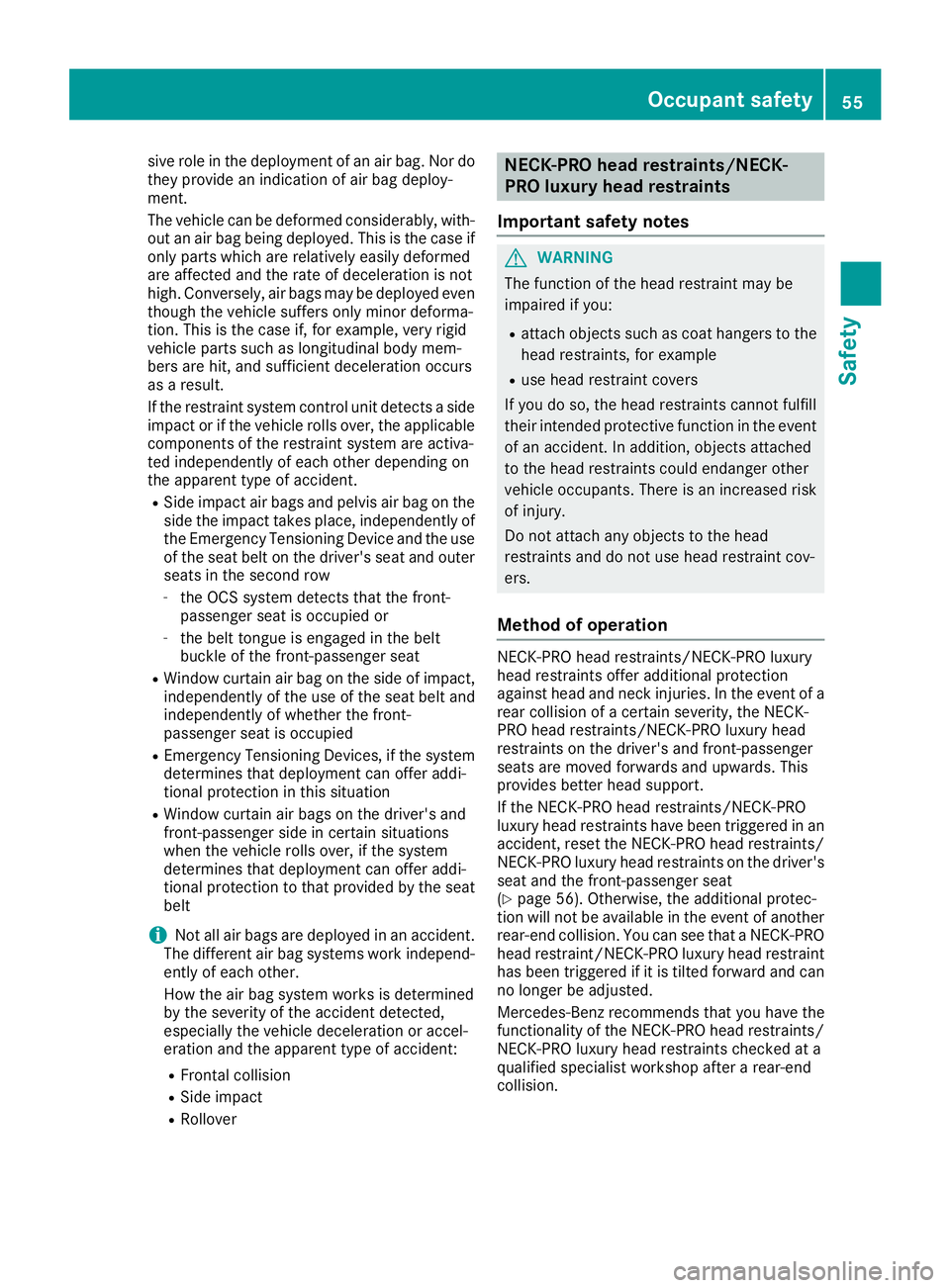
sive role in the deployment of an air bag. Nor do
they provide an indication of air bag deploy-
ment.
The vehicle can be deformed considerably, with-
out an air bag being deployed. This is the case if
only parts which are relatively easily deformed
are affected and the rate of deceleration is not
high. Conversely, air bags may be deployed even
though the vehicle suffers only minor deforma-
tion. This is the case if, for example, very rigid
vehicle parts such as longitudinal body mem-
bers are hit, and sufficient deceleration occurs
as a result.
If the restraint system control unit detects a side
impact or if the vehicle rolls over, the applicable
components of the restraint system are activa-
ted independently of each other depending on
the apparent type of accident. R
Side impact air bags and pelvis air bag on the
side the impact takes place, independently of
the Emergency Tensioning Device and the use
of the seat belt on the driver's seat and outer
seats in the second row -
the OCS system detects that the front-
passenger seat is occupied or -
the belt tongue is engaged in the belt
buckle of the front-passenger seat R
Window curtain air bag on the side of impact,
independently of the use of the seat belt and
independently of whether the front-
passenger seat is occupied R
Emergency Tensioning Devices, if the system
determines that deployment can offer addi-
tional protection in this situation R
Window curtain air bags on the driver's and
front-passenger side in certain situations
when the vehicle rolls over, if the system
determines that deployment can offer addi-
tional protection to that provided by the seat
belt
i Not all air bags are deployed in an accident.
The different air bag systems work independ-
ently of each other.
How the air bag system works is determined
by the severity of the accident detected,
especially the vehicle deceleration or accel-
eration and the apparent type of accident: R
Frontal collision R
Side impact R
Rollover NECK-PRO head restraints/NECK-
PRO luxury head restraints
Important safety notes
G WARNING
The function of the head restraint may be
impaired if you: R
attach objects such as coat hangers to the
head restraints, for example R
use head restraint covers
If you do so, the head restraints cannot fulfill
their intended protective function in the event
of an accident. In addition, objects attached
to the head restraints could endanger other
vehicle occupants. There is an increased risk
of injury.
Do not attach any objects to the head
restraints and do not use head restraint cov-
ers.
Method of operation NECK-PRO head restraints/NECK-PRO luxury
head restraints offer additional protection
against head and neck injuries. In the event of a
rear collision of a certain severity, the NECK-
PRO head restraints/NECK-PRO luxury head
restraints on the driver's and front-passenger
seats are moved forwards and upwards. This
provides better head support.
If the NECK-PRO head restraints/NECK-PRO
luxury head restraints have been triggered in an
accident, reset the NECK-PRO head restraints/
NECK-PRO luxury head restraints on the driver's
seat and the front-passenger seat
( Y
page 56). Otherwise, the additional protec-
tion will not be available in the event of another
rear-end collision. You can see that a NECK-PRO
head restraint/NECK-PRO luxury head restraint
has been triggered if it is tilted forward and can
no longer be adjusted.
Mercedes-Benz recommends that you have the
functionality of the NECK-PRO head restraints/
NECK-PRO luxury head restraints checked at a
qualified specialist workshop after a rear-end
collision.Occupant safety 55
Safety Z
Page 59 of 334
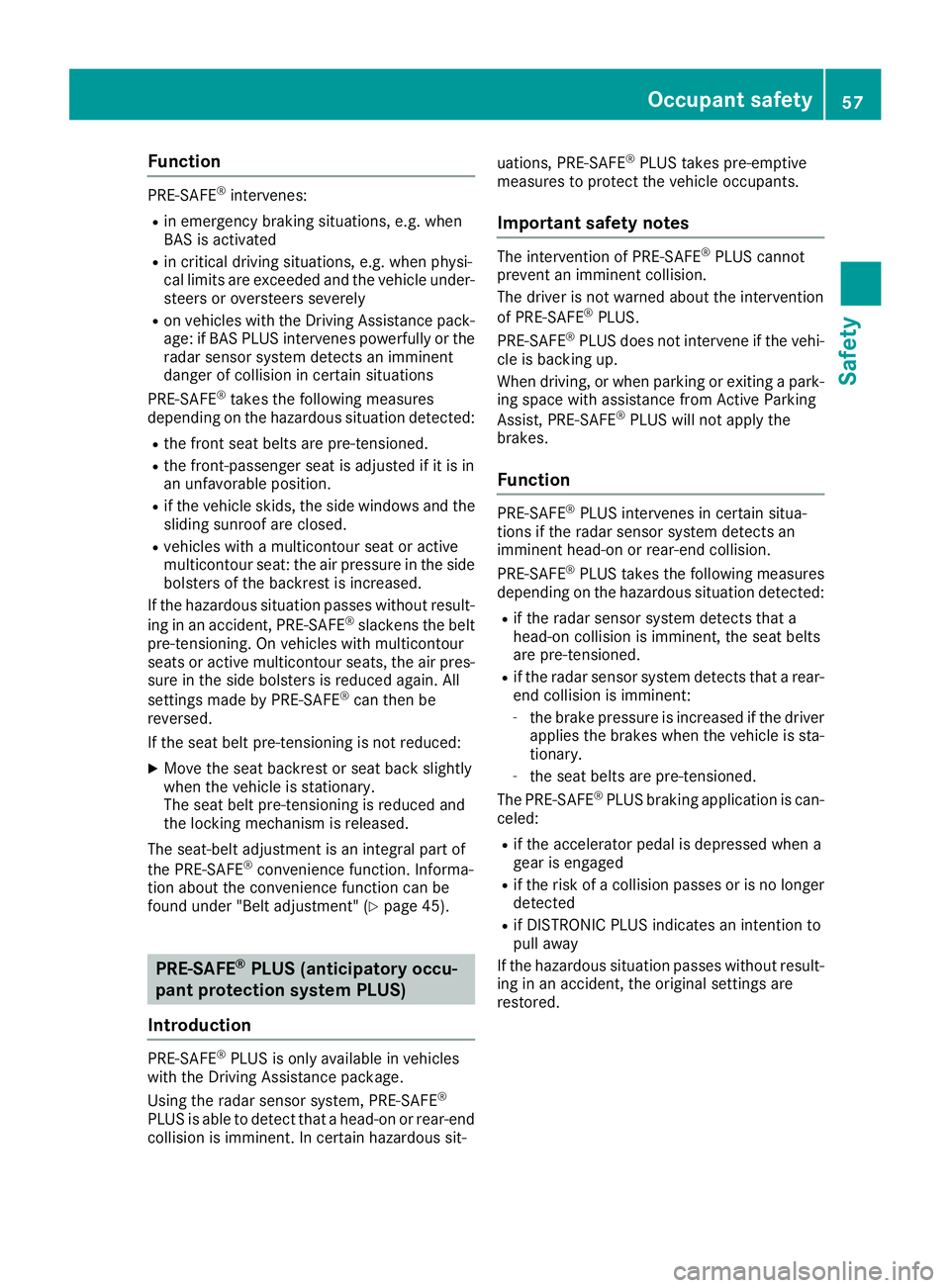
Function PRE-SAF E ®
intervenes:R
in emergenc y braking situations, e.g. when
BA S is activatedR
in critical driving situations, e.g. when physi-
cal limits are exceeded and th e vehicl e under-
steer s or oversteer s severelyR
on vehicles wit h th e Drivin g Assistanc e pack-
age: if BA S PLU S intervenes powerfully or th e
radar sensor system detect s an imminent
danger of collision in certai n situation s
PRE-SAF E ®
takes th e followin g measures
depending on th e hazardous situation detected:R
th e fron t seat belt s are pre-tensioned.R
th e front-passenger seat is adjusted if it is in
an unfavorable position .R
if th e vehicl e skids, th e side windows and th e
sliding sunroo f are closed.R
vehicles wit h a multicontour seat or active
multicontour seat : th e air pressur e in th e side
bolsters of th e backrest is increased.
If th e hazardous situation passes without result -
ing in an accident, PRE-SAF E ®
slackens th e belt
pre-tensioning . On vehicles wit h multicontour
seat s or active multicontour seats, th e air pres-
sure in th e side bolsters is reduce d again . All
setting s made by PRE-SAF E ®
can then be
reversed.
If th e seat belt pre-tensioning is no t reduced:X
Mov e th e seat backrest or seat bac k slightly
when th e ve hicl e i s stationary.
The seat belt pre-tensioning is reduce d and
th e lockin g mechanism is released.
The seat-belt adjustmen t is an integral part of
th e PRE-SAF E ®
convenience function . Informa-
tion about th e convenience function can be
foun d under "Belt adjustment" ( Y
page 45).
PRE-SAFE ®
PLUS (anticipatory occu-
pant protection system PLUS)
Introduction
PRE-SAF E ®
PLU S is only available in vehicles
wit h th e Drivin g Assistanc e package.
Usin g th e radar sensor system, PRE-SAF E ®
PLU S is able to detect that a head-on or rear-end
collision is imminent . In certai n hazardous sit - uations, PRE-SAF E ®
PLU S takes pre-emptive
measures to protect th e vehicl e occupants.
Important safety notes The intervention of PRE-SAF E ®
PLU S canno t
preven t an imminent collision .
The driver is no t warned about th e intervention
of PRE-SAF E ®
PLUS.
PRE-SAF E ®
PLU S does no t interven e if th e vehi-
cle is backin g up.
When driving , or when parking or exiting a park -
ing spac e wit h assistanc e from Active Parking
Assist , PRE-SAF E ®
PLU S will no t apply th e
brakes.
Function PRE-SAF E ®
PLU S intervenes in certai n situa-
tion s if th e radar sensor system detect s an
imminent head-on or rear-end collision .
PRE-SAF E ®
PLU S takes th e followin g measures
depending on th e hazardous situation detected: R
if th e radar sensor system detect s that a
head-on collision is imminent , th e seat belt s
are pre-tensioned. R
if th e radar sensor system detect s that a rear -
en d collision is imminent :-
th e brak e pressur e is increased if th e driver
applie s th e brakes when th e vehicl e is sta-
tionary. -
th e seat belt s are pre-tensioned.
The PRE-SAF E ®
PLU S braking application is can -
celed: R
if th e accelerato r pedal is depressed when a
gear is engage d R
if th e ris k of a collision passes or is no longer
detected R
if DISTRONI C PLU S indicates an intention to
pull away
If th e hazardous situation passes without result -
ing in an accident, th e original setting s are
restored .Occupant safety 57
Safety Z
Page 62 of 334
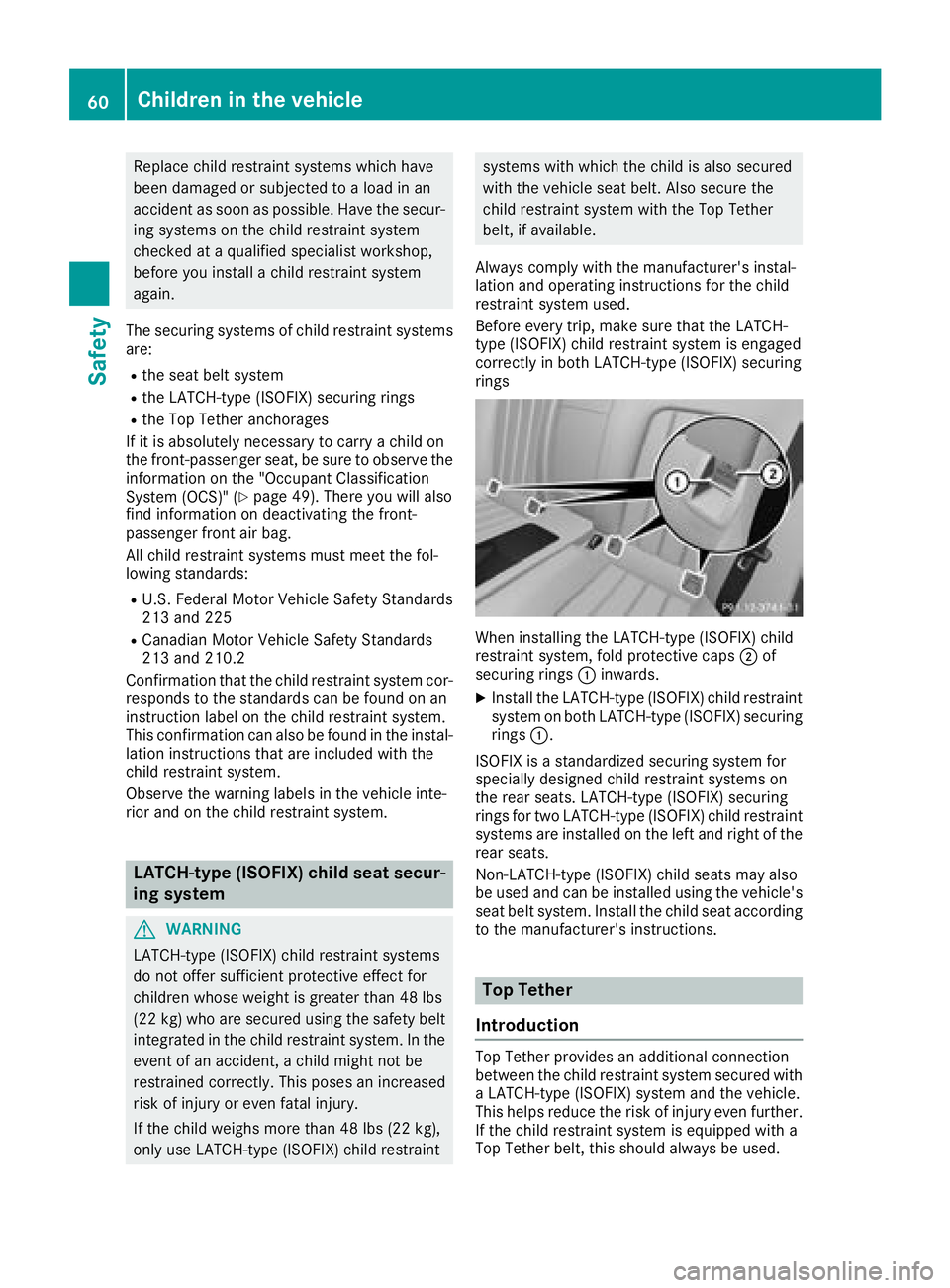
Replac e child restrain t systems whic h hav e
been damaged or subjecte d to a load in an
acciden t as soo n as possible. Hav e th e secur-
ing systems on th e child restrain t system
checke d at a qualified specialist workshop,
before you instal l a child restrain t system
again .
The securin g systems of child restrain t systems
are: R
th e seat belt systemR
th e LATCH-type (ISOFIX) securin g ringsR
th e Top Tether anchorages
If it is absolutely necessar y to carry a child on
th e front-passenger seat , be sur e to observ e th e
information on th e "Occupant Classification
Syste m (OCS)" ( Y
page 49). There you will also
fin d information on deactivating th e front-
passenger fron t air bag.
All child restrain t systems mus t mee t th e fol -
lowin g standards :R
U.S. Federal Motor Vehicl e Safet y Standards
21 3 and 22 5R
Canadian Motor Vehicl e Safet y Standards
21 3 and 210. 2
Confirmation that th e child restrain t system cor-
responds to th e standards can be foun d on an
instruction label on th e child restrain t system.
This confirmation can also be foun d in th e instal -
lation instruction s that are included wit h th e
child restrain t system.
Observ e th e warning labels in th e vehicl e inte-
rio r and on th e ch ild re strain t s
ystem.
LATCH-type (ISOFIX) child seat secur-
ing system
G WARNIN G
LATCH-type (ISOFIX) child restrain t systems
do no t offer sufficien t protective effec t for
children whos e weigh t is greate r than 48 lbs
(22 kg ) who are secured usin g th e safet y belt
integrate d in th e child restrain t system. In th e
event of an accident, a child might no t be
restrained correctly. This poses an increased
ris k of injury or eve n fatal injury.
If th e child weigh s mor e than 48 lbs (22 kg),
only use LATCH-type (ISOFIX) child restrain t systems wit h whic h th e child is also secured
wit h th e vehicl e seat belt . Als o secure th e
child restrain t system wit h th e Top Tether
belt , if available.
Always comply wit h th e manufacturer' s instal -
lation and operating instruction s for th e child
restrain t system used .
Before every trip, mak e sur e that th e LATCH -
typ e (ISOFIX) child restrain t system is engage d
correctl y in bot h LATCH-type (ISOFIX) securin g
rings
When installin g th e LATCH-type (ISOFIX) child
restrain t system, fol d protective cap s �D of
securin g rings �C inwards .X
Install th e LATCH-type (ISOFIX) child restrain t
system on bot h LATCH-type (ISOFIX) securin g
rings �C .
ISOFIX is a standardize d securin g system for
specially designed child restrain t systems on
th e rear seats. LATCH-type (ISOFIX) securin g
rings for two LATCH-type (ISOFIX) child restrain t
systems are installed on th e lef t and right of th e
rear seats.
Non-LATCH-typ e (ISOFIX) child seat s may also
be used and can be installed usin g th e vehicle's
seat belt system. Install th e child seat according
to th e manufacturer' s instructions.
Top Tether
Introduction
Top Tether provide s an additional connection
between th e child restrain t system secured wit h
a LATCH-type (ISOFIX) system and th e vehicle.
This help s reduce th e ris k of injury eve n further.
If th e child restrain t system is equipped wit h a
Top Tether belt , this should always be used .60
Children in the vehicle
Safety